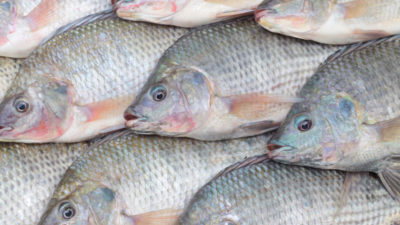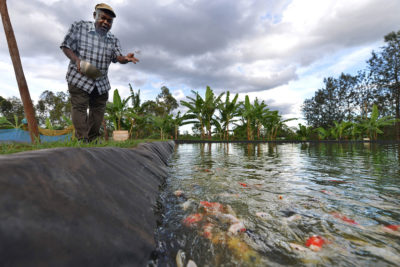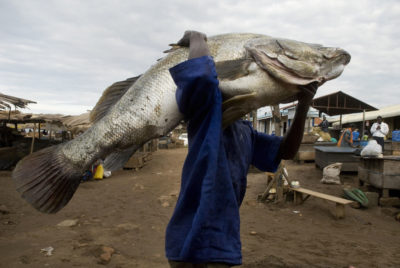In 1995, Adrian Piers, a veteran aquaculture consultant, imported a batch of Australian red claw crayfish to the tiny southern African monarchy of Swaziland. He began raising the attractive blue-green crustaceans — the males of which have red stripes on their claws and can weigh a little more than a pound — in ponds rented from a sugar estate, and soon found a market for them among French-style chefs in neighboring South Africa.
In 2001, citing lower-than-desired profits, he closed his operation in Swaziland and legally moved some crayfish almost 750 miles north to his home country of Zambia. Piers kept them temporarily at Kafue Fisheries, a friend’s commercial farm, while searching for a permanent place to breed them. “Unfortunately he was a bit new to the crayfish, and they managed to get out,” Piers explains. The crayfish were soon found thriving in the nearby Kafue River, one of Zambia’s largest, and in waterways near his old Swazi farm, too, even though he had dried out his ponds before he left. Someone (Piers won’t say who) then unofficially put some in Lake Kariba, the giant man-made lake between Zambia and Zimbabwe, where they are now proliferating.
Piers no longer farms red claw crayfish — in fact, no one appears to be farming them at scale in Africa — but they are spreading rapidly throughout the southern part of the continent, from Swaziland into nearby parts of South Africa and Mozambique, through the Kafue River system, up and down the mighty Zambezi, and into Namibia and Zimbabwe. Biologists now fear that the invasive red claw could reach the renowned Okavango Delta and radically disrupt the ecology of that Botswanan wildlife paradise, which supports an economically vital ecotourism industry.
Africa’s fast-growing human population demands ever-more fish, and with most of the continent’s wild fish populations fully exploited, investors are seeing new opportunities in aquaculture. Yet in the rush to promote fish farming, some are ignoring lessons from the recent past and introducing potentially harmful species to major water bodies, often without meaningful prior research, governmental control, or even viable business plans. The problem of aquatic invasive species in Africa is understudied and these species are now threatening the ecology of natural jewels like Lake Malawi.
Fish farming was promoted across Africa during the European colonial era as a poverty alleviation tool.
One of Africa’s giant Rift Valley lakes, Lake Malawi is often called the “Galapagos Islands of freshwater” because its hundreds of species of endemic cichlid fish have provided groundbreaking insights into evolution and how species adapt to different environments. Scientists say that a small-time Tanzanian businessman has apparently introduced an invasive aquaculture fish, the Nile tilapia, into the lake within the last year and that these fish could hybridize with ecologically and economically important native tilapia species and perhaps drive many other endemic fish to extinction.
People have long been trying to “improve” Africa’s fisheries by introducing new species from elsewhere on the continent and from around the world, says Peter Britz, an aquaculture expert at South Africa’s Rhodes University. Britz says that “ideologically driven” fish farming was promoted across Africa during the European colonial era as a poverty alleviation tool. Many projects collapsed, he says, because they were not sufficiently productive, were culturally unsuitable, or could not find markets. Nevertheless, post-colonial donors also promoted unsuitable aquaculture for years after its problems had become apparent.
“The idea of supporting the poorest of the poor is so compelling that the outcomes were often ignored,” says Britz.
Aquaculture also created ecological problems. The poster child for African aquaculture-associated invasive species is the Nile perch, a very large North African fish whose introduction into Lake Victoria in the 1950s contributed to the extinction of hundreds of its colorful endemic cichlid fish species. Nile perch are voracious predators, and they wiped out many of the lake’s much smaller indigenous fish, simplifying the natural food web and destroying traditional near-shore fisheries. Indigenous fish had traditionally been preserved by drying them in the sun; big, fatty Nile perch must be smoked over wood, which drove deforestation once fishermen figured out how to catch the massive newcomers without breaking their nets.
William Kiarie feeds goldfish at his fish farm in Sagana, Kenya, where he also raises tilapia and catfish. Tony Karumba / AFP / Getty
Predatory bass and trout species brought from the Northern Hemisphere to South Africa by colonial anglers continue to eliminate small native fish from many rivers. Asian carp have been put into South African waters and, as with Adrian Piers, aquaculturists have also experimented with invertebrates like crayfish.
Many freshwater crayfish species are fast-breeding, voracious omnivores that eat plants and animal matter, living or dead, and can therefore be high-impact invaders that alter the structure and function of ecosystems. Africa has no native freshwater crayfish and thus no predators or diseases evolved to keep them in check. After American red swamp crayfish were introduced to Kenya’s Lake Naivasha in 1970, they multiplied rapidly and turned the once-clear lake murky by killing huge numbers of aquatic plants.
The impacts of the Australian red claw that Piers and others have more recently brought to Africa remain virtually unstudied; researchers lack funds even for basic monitoring of the crayfish’s rapid spread. One scientist found that native predatory fish were eating small crayfish in the Kafue River and may be benefiting from them, but some Zambian fishermen say that some native fish have become scarce after the red claw invasion, and they suspect that crayfish are eating fish eggs or somehow altering the ecosystem. Red claws often damage fish caught in local fishermen’s gillnets, prompting some tribal leaders in Zambia to make formal protests to the government.
Biologists are concerned about the spread of the invasive red claw crayfish into the Okavango Delta.
Aquatic biologists and conservationists are highly concerned about the potential spread of the red claw crayfish into the Okavango Delta in northern Botswana.The crayfish are now upstream of an ephemeral natural channel that links the Zambezi system and the delta in high rainfall years, and they are moving downstream.
Formed where the Okavango River runs out into the sandy savanna of the Kalahari, the delta features in hundreds of documentary films and hosts some of the world’s premier wildlife lodges. The river floods the delta annually, filling dry channels and forming nurseries for millions of fish and frogs, which are preyed upon by huge numbers of birds and mammals. It is currently almost free of aquatic invasives.
Mike Murray-Hudson, a wetland ecologist with the Okavango Research Institute, says that the Okavango’s aquatic ecosystem is notable in that detritivores — organisms that break down organic detritus like dead leaves — are underrepresented. The red claw is an efficient detritivore. There is a large store of carbon in the Okavango’s detritus because it breaks down so slowly, he says, “and we don’t want an accelerator in the system.” Because of their omnivorous habits, other biologists are concerned that the red claw will consume fish and amphibian eggs and destroy aquatic vegetation.
Murray-Hudson says that despite the risk, no one is making concrete plans to keep crayfish out of the Delta. “It’s the usual story,” he says. “We don’t have enough people and money, and I suspect that it’s going to take a crisis to make us sit up and do something about it.”
Africa’s aquaculture industry is likely to expand in coming years, says Rhodes University’s Britz, who sees the dawn of a new, profitable era driven by private business. A 2013 World Bank study estimates that sub-Saharan Africa will have a “fish deficit” of more than 1.8 million tons by 2030. This will be filled by imports (chiefly from Asia) and local aquaculture. Expensive niche products like red claw crayfish won’t satisfy Africa’s appetite for cheap protein; that will be up to species like the Nile tilapia, the “broiler chicken of fish.”
Nile perch, such as this 80-kilogram one caught in Uganda, devastated native species in Lake Victoria after being introduced in the 1950s. Walter Astrada / AFP / Getty
The Nile tilapia, Oreochromis niloticus, is an entirely different — and far smaller — fish species than the Nile perch, Lates niloticus. However, both are used in aquaculture, and both, as introduced species, have contributed to the disruption of ecosystems in Lake Victoria and elsewhere.
The Nile tilapia, which naturally occurs across a broad swath of North Africa, was first cultured more than 3,000 years ago by ancient Egyptians. Many other species of tilapia are found in various parts of Africa, many are traditional food fish, and some have been used in aquaculture. But in recent decades, fish breeders (many in Asia) have zeroed in on the Nile tilapia as the ultimate aquaculture species and bred a large variety of strains and hybrids. The Nile tilapia is considered environmentally low-impact because modern strains have an extremely good feed conversion ratio: Producing 1 kilogram of farmed Nile tilapia takes only 1.5 kilograms of pelleted food, of which only 2 to 3 percent is dry fishmeal, says Britz. It grows quickly and can deal with suboptimal conditions.
Large-scale commercial tilapia farming operations are profitable in many African countries, foreign companies are looking to invest further, and development agencies have aggressively promoted modern Nile tilapia strains over local species. The Nile tilapia is thus regularly introduced into new areas of the continent, where, given suitably warm water, it often thrives as a top-class invasive. Not only can it dominate food resources and change aquatic ecosystems to the detriment of other fish, but it readily breeds with other native tilapia species, thus “contaminating” their gene pool and ultimately wiping them out via what scientists call hybrid introgression.
The Nile tilapia can dominate food resources and change aquatic ecosystems to the detriment of other fish.
For example the Kariba tilapia, Oreochromis mortimeri, is endemic to the middle section of the Zambezi River. In 2007 it was classified as critically endangered on the IUCN Red List of threatened species, having experienced an 80 percent population decline in the preceding ten years because the introduced Nile tilapia was aggressively displacing and hybridizing with it. Some ichthyologists and fishermen say the Kariba tilapia is now probably extinct, but this has not been confirmed. Somewhat ironically, fish breeders now fear that wild populations of Nile tilapia will be wiped out by invasive captive-bred strains, thus destroying the natural raw material from which these super-fish have been built.
Martin Genner, a University of Bristol icthyologist with extensive experience in Africa, says that his research indicates that in Tanzania, “there is zero evidence that Nile tilapia will grow faster or have a better food conversion efficiency than local tilapia species when kept in the same conditions,” but that “everyone is under the illusion that their problems will be solved by having a different fish species.”
What can be done to prevent local species from being overwhelmed by introduced Nile tilapia?
Many conservationists advocate refuges protected by laws and physical barriers; the headwaters of a river basin could be declared off-limits to Nile tilapia, and weirs built to prevent introduced fish from swimming upstream. But critics say all it takes is one discreetly unscrupulous person with a bucket to render barriers and laws useless. “Pure” wild tilapia could also be kept in facilities outside their natural range, but such populations don’t always survive and may evolve to suit their new captive environment, possibly losing useful wild genes. And removing Nile tilapia and other aquatic invasives from large water bodies is practically impossible – current fish poisons are not specific and wipe out non-target fish and amphibians, too.
Is the loss of natural aquatic biodiversity the inevitable price of providing affordable protein for Africa’s growing human population? Perhaps, but it’s a high price to pay.





